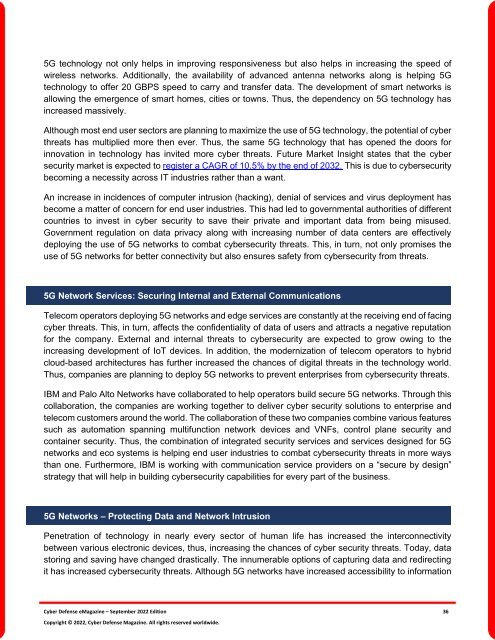Cyber Defense eMagazine September Edition for 2022 #CDM
#CYBERDEFENSEMAG @CyberDefenseMag by @Miliefsky a world-renowned cyber security expert and the Publisher of Cyber Defense Magazine as part of the Cyber Defense Media Group as well as Yan Ross, Editor-in-Chief and many more writers, partners and supporters who make this an awesome publication! Thank you all and to our readers! OSINT ROCKS! #CDM #CDMG #OSINT #CYBERSECURITY #INFOSEC #BEST #PRACTICES #TIPS #TECHNIQUES
#CYBERDEFENSEMAG @CyberDefenseMag by @Miliefsky a world-renowned cyber security expert and the Publisher of Cyber Defense Magazine as part of the Cyber Defense Media Group as well as Yan Ross, Editor-in-Chief and many more writers, partners and supporters who make this an awesome publication! Thank you all and to our readers! OSINT ROCKS! #CDM #CDMG #OSINT #CYBERSECURITY #INFOSEC #BEST #PRACTICES #TIPS #TECHNIQUES
You also want an ePaper? Increase the reach of your titles
YUMPU automatically turns print PDFs into web optimized ePapers that Google loves.
5G technology not only helps in improving responsiveness but also helps in increasing the speed of<br />
wireless networks. Additionally, the availability of advanced antenna networks along is helping 5G<br />
technology to offer 20 GBPS speed to carry and transfer data. The development of smart networks is<br />
allowing the emergence of smart homes, cities or towns. Thus, the dependency on 5G technology has<br />
increased massively.<br />
Although most end user sectors are planning to maximize the use of 5G technology, the potential of cyber<br />
threats has multiplied more then ever. Thus, the same 5G technology that has opened the doors <strong>for</strong><br />
innovation in technology has invited more cyber threats. Future Market Insight states that the cyber<br />
security market is expected to register a CAGR of 10.5% by the end of 2032. This is due to cybersecurity<br />
becoming a necessity across IT industries rather than a want.<br />
An increase in incidences of computer intrusion (hacking), denial of services and virus deployment has<br />
become a matter of concern <strong>for</strong> end user industries. This had led to governmental authorities of different<br />
countries to invest in cyber security to save their private and important data from being misused.<br />
Government regulation on data privacy along with increasing number of data centers are effectively<br />
deploying the use of 5G networks to combat cybersecurity threats. This, in turn, not only promises the<br />
use of 5G networks <strong>for</strong> better connectivity but also ensures safety from cybersecurity from threats.<br />
5G Network Services: Securing Internal and External Communications<br />
Telecom operators deploying 5G networks and edge services are constantly at the receiving end of facing<br />
cyber threats. This, in turn, affects the confidentiality of data of users and attracts a negative reputation<br />
<strong>for</strong> the company. External and internal threats to cybersecurity are expected to grow owing to the<br />
increasing development of IoT devices. In addition, the modernization of telecom operators to hybrid<br />
cloud-based architectures has further increased the chances of digital threats in the technology world.<br />
Thus, companies are planning to deploy 5G networks to prevent enterprises from cybersecurity threats.<br />
IBM and Palo Alto Networks have collaborated to help operators build secure 5G networks. Through this<br />
collaboration, the companies are working together to deliver cyber security solutions to enterprise and<br />
telecom customers around the world. The collaboration of these two companies combine various features<br />
such as automation spanning multifunction network devices and VNFs, control plane security and<br />
container security. Thus, the combination of integrated security services and services designed <strong>for</strong> 5G<br />
networks and eco systems is helping end user industries to combat cybersecurity threats in more ways<br />
than one. Furthermore, IBM is working with communication service providers on a “secure by design”<br />
strategy that will help in building cybersecurity capabilities <strong>for</strong> every part of the business.<br />
5G Networks – Protecting Data and Network Intrusion<br />
Penetration of technology in nearly every sector of human life has increased the interconnectivity<br />
between various electronic devices, thus, increasing the chances of cyber security threats. Today, data<br />
storing and saving have changed drastically. The innumerable options of capturing data and redirecting<br />
it has increased cybersecurity threats. Although 5G networks have increased accessibility to in<strong>for</strong>mation<br />
<strong>Cyber</strong> <strong>Defense</strong> <strong>eMagazine</strong> – <strong>September</strong> <strong>2022</strong> <strong>Edition</strong> 36<br />
Copyright © <strong>2022</strong>, <strong>Cyber</strong> <strong>Defense</strong> Magazine. All rights reserved worldwide.


















